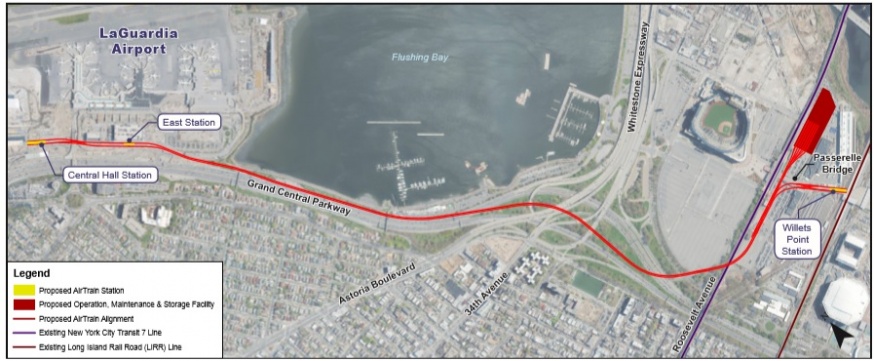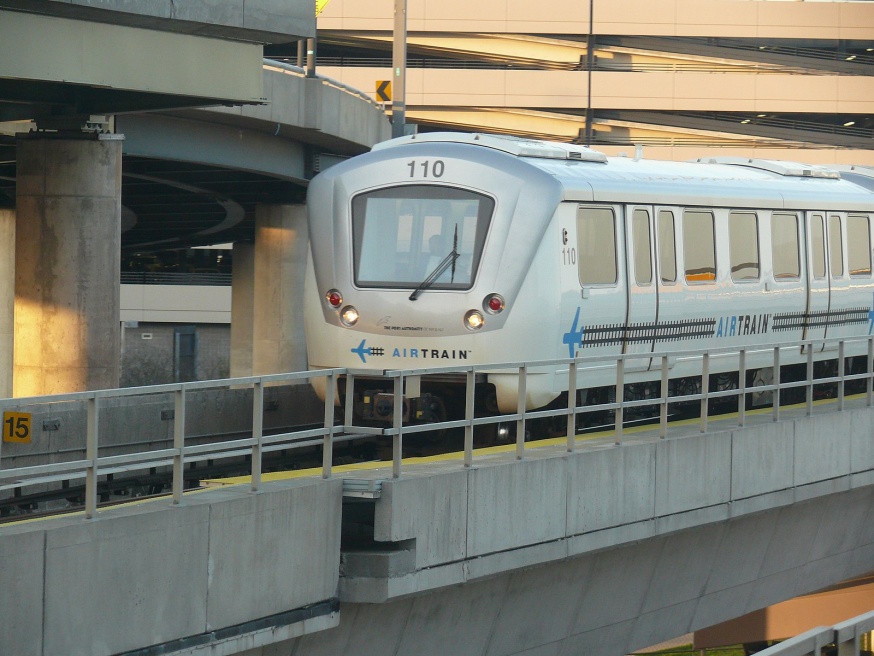
Proposed AirTrain route
March 22, 2021 By Christina Santucci
The LaGuardia AirTrain is one step closer to becoming a reality – with the Federal Aviation Administration (FAA) publishing its final environmental impact statement last week detailing the $2-billion project.
The AirTrain – first proposed by Governor Andrew Cuomo in 2015 – aims to link the airport with the subway system and Long Island Rail Road. The 1.5-mile rail line would connect with the No. 7 train and the Port Washington branch of the LIRR at Willets Point.
The plan calls for three stations, two at LaGuardia Airport terminals and the third at the Willets Point Station.
The Port Authority of New York & New Jersey, which operates LaGuardia Airport, says the project is needed to make travel time between LaGuardia and Manhattan more reliable—saying it would be a 30-minute commute from midtown.
In the executive summary of the more than 600-page impact statement, David Fish, the director at the FAA’s Office of Airports, concluded that he found the project to be “consistent with existing national environmental policies and objectives.”
The Port Authority hailed the final Environmental Impact Statement (EIS) as reaffirming the FAA’s endorsement of the plan.

AirTrain LGA model (FAA)
The final step in the federal review process is when the FAA issues its Record of Decision– which will explain whether it approves of the project. This is expected to happen later this spring – at least 30 days after a notice of availability for the EIS is published in the Federal Register.
The FAA’s approval is needed because the Port Authority wants to use fees collected directly from airport passengers to fund the AirTrain project.
Initial stages of construction could begin in June – with most of the work commencing in March 2022, the new EIS noted. With this timeline, the AirTrain could be operational by December 2025, according to the document.
Last summer, the agency had issued a draft environmental impact statement and opened the public comment period – during which time the FAA received more than 4,000 submissions on the AirTrain plan.
Among those commenters were U.S. Rep. Grace Meng, state Assembly member Jeffrion Aubry and state Sen. Jessica Ramos, who wrote that the project “will not help, but harm my community especially during a pandemic.”
The AirTrain has faced heavy opposition from many East Elmhurst residents, since it would be constructed on an elevated rail line that would go by their neighborhood and along the Flushing Promenade.
Residents and some politicians say the train would be noisy and were concerned about the environmental impacts of the project. Critics also argue that the 7 train is already overcrowded and that the airport travelers would make it worse.
U.S. Rep. Alexandria Ocasio-Cortez had also expressed her opposition to the plan last year.
Some suggested other ways of connecting travelers to the airport, such as extending the N/W subway line that now ends in Astoria at 31st Avenue and Ditmars Boulevard.
“I urge the FAA to reject the proposal and instead explore alternatives such as expanding bus access and the possibility of an extension to the N and W subway lines,” Ramos wrote in her comments.
But the FAA said a total of 47 ideas – such as seven subway extension plans – were studied, and only the AirTrain met the criteria, which included standardizing travel times to LaGuardia Airport, reducing traffic congestion and being “reasonable to construct and operate.”
The Port Authority issued a statement about the final EIS.
“This milestone represents a very important step forward in building a rapid, reliable and sustainable rail mass transit link to the airport,” the agency wrote.
The Port Authority touted work opportunities that the AirTrain is expected to bring – including about 3,000 union construction jobs plus more than $500 million in contracting opportunities for minority and women-owned businesses as well as contracting opportunities for Queens-based businesses.
Officials are also aiming to employ local residents, with a goal of hiring 80 percent of the permanent operations and maintenance workers from the 16 zip codes closest to the airport.
An estimated $50 million would also be used to benefit nearby parks and community facilities – $23 million for enhancements of the Flushing Bay Promenade, at least $20 million for improvements in Flushing Meadows Corona Park and other nearby parks, and $7.5 million for maintenance of the promenade, the Port Authority said.
The Port Authority also plans to provide up to $75,000 per year during construction for programming at parks in collaboration with the East Elmhurst Corona Civic Association.

JFK AirTrain (Ad Meskens/ Wikimedia Commons)
2 Comments

N and W trains should have been extended decades ago to go all the way to LGA. Right now this is a joke of a connection.
Neither Governor Cuomo, Port Authority Chairman Cotton, MTA Chairman Foye, LIRR President Eng and NYC Transit Interim President Feinberg has ever revealed what the additional operating costs would be to provide supporting LIRR & NYC Transit service. No one has identified the funding sources to pay for increasing frequency of service.
Only Governor Cuomo, the Port Authority, their consultants along with labor unions and construction contractors who would benefit by this project, refuse to acknowledge the reality that a thirty minute trip is fantasy.
In 2014, Cuomo said the cost for the LaGuardia Air Train was $450 million with a completion date of 2019. The Port Authority has budgeted $2.05 billion of funding within the $37 billion 2017 – 2026 Ten Year Capital Plan for the project with a completion date of 2025. This doesn’t include several hundred million more which is necessary to relocate the NYC Transit Flushing Casey Stangel Bus Depot. There is no funding within the MTA $51 billion 2020 – 2024 to pay for this cost. Who will pay for the additional costs if the construction bids come in above the available funding? Who can guarantee the final cost and completion date?.
(Larry Penner is a transportation advocate, historian and writer who previously worked for the Federal Transit Administration Region 2 New York Office. This included the development, review, approval and oversight for billions in capital projects and programs for the MTA, NYC Transit, Long Island Rail Road along with 30 other transit agencies in NY & NJ)